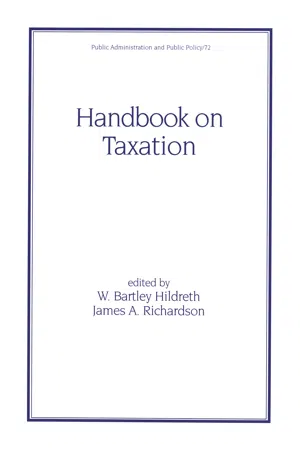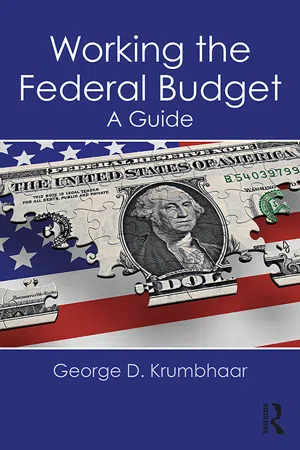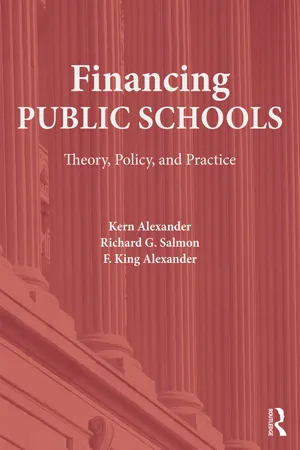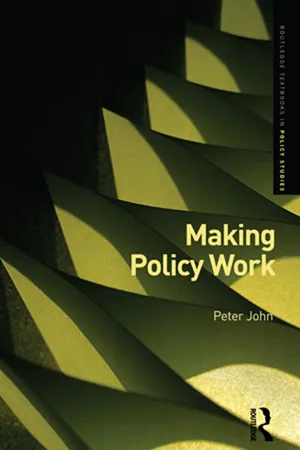Economics
Taxation
Taxation refers to the process of imposing a financial charge or levy by a government on individuals, businesses, or other entities to fund public expenditures. It is a key tool for governments to generate revenue for public services and infrastructure. Taxation can also be used to influence economic behavior and redistribute wealth.
Written by Perlego with AI-assistance
Related key terms
10 Key excerpts on "Taxation"
- eBook - ePub
- Gary Hull(Author)
- 2017(Publication Date)
- Routledge(Publisher)
Chapter VIII Of Taxation.Section I Of the Effect of all hinds of Taxation in general.
Taxation is the transfer of a portion of the national products from the hands of individuals to those of the government, for the purpose of meeting the public consumption or expenditure. Whatever be the denomination it bears, whether tax, contribution, duty, excise, custom, aid, subsidy,* grant, or free gift, it is virtually a burthen imposed upon individuals, either in a separate or corporate character, by the ruling power for the time being, for the purpose of supplying the consumption it may think proper to make at their expense; in short, an impost, in the literal sense.It would be foreign to the plan of this work, to inquire in whom the right of Taxation is or ought to be vested. In the science of political economy, Taxation must be considered as matter of fact, and not of right; and nothing further is to be regarded, than its nature, the source whence it derives the values it absorbs, and its effect upon national and individual interests. The province of this science extends no further.The object of Taxation is, not the actual commodity, but the value of the commodity, given by the tax-payer to the tax-gatherer. Its being paid in silver, in goods, or in personal service, is a mere accidental circumstance, which may be more or less advantageous to the subject or to the sovereign. The essential point is, the value of the silver, the goods, or the service. The moment that value is parted with by the tax-payer, it is positively lost to him; the moment it is consumed by the government or its agents, it is lost to all the world, and never reverts to, or re-exists in society, This, I apprehend, has already been demonstrated, when the general effect of public consumption was under consideration. It was there shown, that however the money levied by Taxation may be refunded to the nation, its value is never refunded; because it is never returned gratuitously, or refunded by the public functionaries, without receiving an equivalent in the way of barter or exchange. - eBook - ePub
The Economy of Ireland
National and Sectoral Policy Issues
- John W. O'Hagan, Carol Newman, John W. O'Hagan, Carol Newman(Authors)
- 2014(Publication Date)
- Gill Books(Publisher)
CHAPTER 4 TaxationMicheál Collins1 INTRODUCTIONTaxation is a method for government to raise revenue by means of charges on persons or firms and it can be collected nationally or locally. Governments collect taxes for two broad reasons. First, taxes provide revenue to run the state, as outlined in Chapter 3, and pay for the provision of public services, infrastructure, and the funding of redistributive policies. Second, Taxation is used by governments as a corrective device to alter the behaviour of individuals, firms or the economy as a whole. In such cases, governments can use Taxation to, for example, discourage certain consumption choices, encourage investment in certain sectors, or reduce citizens’ disposable income in an attempt to dampen the demand side of the economy.In Ireland, the government alters its Taxation policies annually via the Budget and Finance Act. However, the government’s ability to choose these policies freely is limited by competitive forces, EU rules, rates in neighbouring jurisdictions and historical factors. In the case of the first of these, a small open economy such as Ireland cannot easily alter its company Taxation structures without having consideration of the Taxation regimes in competing economies. Similarly, the government is limited by EU rules which require it to adhere to certain fiscal targets and it is restricted by EU single market rules from altering many of its consumption taxes. Past economic policies funded through government borrowing also reduce Taxation choices as this debt must be serviced and repaid from current Taxation revenues.The plan of this chapter is as follows. In Section 2 we consider the principles of a good Taxation system. Section 3 considers the operation and features of the Taxation system in Ireland and reviews that structure in both historical and international contexts. In Sections 4 and 5 we evaluate the Irish Taxation system, first looking at taxes on income and then examining indirect Taxation, corporation tax and property taxes. Section 6 discusses the issue of deferred Taxation, namely borrowing, building on the discussion of this topic in Chapter 3. Section 7 concludes the chapter. - eBook - ePub
Taxation by Political Inertia
Financing the Growth of Government in Britain
- Richard Rose, Terence Karran(Authors)
- 2018(Publication Date)
- Routledge(Publisher)
It is attractive for politicians averse to raising tax rates and broadening the tax base to rely upon economic growth rather than increased tax effort to produce more tax revenue. Each increase in tax effort induces a disproportionate decrease in take-home pay. If a government claims 40 per cent of the national product in Taxation, an increase in tax effort to 45 per cent will reduce the private-sector share by 8.3 per cent (that is, from 60 to 55 per cent).The reasons why government favours economic growth are multiple: in a booming economy there is a lot more money to spend, and fewer political difficulties. Moreover, as economic growth is cumulative, in the course of a five-year Parliament an annual growth rate of 2.5 per cent will, by a process of compounding, increase the national product by 16 per cent, and total tax revenue with it.Viewing the economy as a source of tax revenue imposes a one-dimensional perspective upon a multi-dimensional set of activities. Models of the economy designed to illustrate processes important in economic theory often give very little attention to Taxation. From a broad economic perspective, issues of prices and wages, investment and growth and foreign exchange rates appear of pervasive importance. Taxation appears only as an intervening variable in the economic system as a whole (Wallis et al., 1984). In many contexts, Taxation can be seen as a fiscal instrument used for ulterior, non-revenue ends. Economic activities are reduced by tax laws to such categories as taxable income, or goods liable to value added tax. The flow of income and expenditure through the economy is not the concern of tax authorities, whose primary job is to divert a portion of that flow to the fisc through appropriate administrative means.Certainty and PredictabilityGovernment is concerned with the certainty of revenue and, because budgets are statements about future taxing and spending, about the predictability of revenue. A good tax is not only easy to collect but also will yield an amount of revenue that can be predicted when forecasts are required for the budget in the year ahead. Otherwise the Treasury may make policies based upon misleading assumptions about the public-sector borrowing requirement, the difference between the forecast total expenditure and total revenue. - eBook - ePub
- Enrico Colombatto(Author)
- 2016(Publication Date)
- Routledge(Publisher)
6 Taxation and regulationDOI: 10.4324/9781315658988-76.1 On the role of government
Governments play a substantial role in today's economies. They try to stabilise the business cycle through monetary and fiscal policies, to intervene in regulating international trade and financial transactions, and to redistribute income to the benefit of the poor members of the community. Moreover, governments engage in restraining or prohibiting activities deemed contrary to the public interest; encouraging the supply of goods and services that the market process would otherwise produce in inadequate amounts; and delivering services that people wish to ban from the marketplace (for example, police, justice and defence).Since the analyses of the role, legitimacy, and effectiveness of government intervention are outside the scope of this book, we shall not investigate the merits of all these actions, nor shall we discuss whether governments keep their word. Rather, we take it for granted that government intervention exists, that most citizens believe it is desirable, and we focus on the tools that governments resort to in order to obtain their goals. We analyse Taxation and regulation in this chapter, deferring to later parts of the book the study of monetary, fiscal and international matters. In particular, the next section presents a general overview of Taxation; sections 6.3 to 6.9 examine the technical features of Taxation and the extent to which it affects taxpayers’ welfare; sections 6.10 and 6.11 deal with regulation.6.2 On tax targeting, tax collecting and tax paying
The world of Taxation includes three key components: tax targeting, tax collecting and tax paying. Tax targeting relates to the economic activities/variables which the tax authorities consider as their goal: specific firms or industries (e.g., to rein in pollution), certain categories of consumption (e.g., to protect individuals’ health against their bad judgement), or some groups of individuals (e.g., for the sake of income redistribution). - eBook - ePub
- W.Bartley Hildreth(Author)
- 2019(Publication Date)
- Routledge(Publisher)
Taxes are imposed by congressional and legislative fiat. Legislation defines the legal incidence of the tax. The excise tax on tobacco is remitted to the government by tobacco wholesalers, but the true incidence of the tax is borne by any number of people, starting with the consumer, to the retailer distributing the product, to the wholesaler, and to the manufacturer. The legal incidence of a tax is clear, but the economic incidence is much more difficult to identify.Legal incidence is important for administrative purposes, but economic incidence is much more significant for estimating and predicting the impact that the tax might have on the economy. The personal income tax will typically have the same legal and economic incidence; that is, the individual taxpayer will remit the tax to the government and will bear the full burden of the tax. The corporate income tax will be remitted to the government by the corporation, but exactly on whom the burden will fall is subject to debate. The stockholders may absorb some of the tax burden, the corporation’s customers may incur some of the tax burden through higher prices, the corporation’s labor and other such inputs may incur some of the tax burden through lower wages or lower rental rates for property or for leased equipment, or there may be some scattering of the tax burden based on market conditions at the time.Every tax that is not directly imposed on an individual will most probably have an economic incidence that will diverge from the legal incidence of the tax. Taxes on businesses; taxes on energy resources; taxes on tobacco, alcoholic beverages, airlines, telecommunication services, and other such products; import fees; and other taxes that are not directly levied on an individual taxpayer will be shifted if at all possible from the entity legally liable for the tax to some other person involved either with the production or consumption of the product. Exactly on whom the tax burden will ultimately fall depends on market conditions.IV. FEDERAL, STATE, AND LOCAL Taxation
Taxation is Taxation from the perspective of someone having to pay the tax. It does not matter if it is levied by the federal government, the state government, or the local government. A person has to pay the tax. Federal, state, and local governments have selected different types of taxes to finance their respective public services, however. The federal government almost exclusively uses the personal income tax and the payroll tax. These taxes provide about 80 percent of all revenues received by the federal government. Corporate taxes make up about 11 percent of all federal tax collections; excise taxes make up about four percent; and other taxes such as inheritance taxes and import fees, make up about five percent of federal tax collections. Federal tax collections are not highly diversified. - Gary Bandy(Author)
- 2014(Publication Date)
- Routledge(Publisher)
A duty is levied on a thing. Most public managers do not need to concern themselves with issues relating to tax collection but they need to manage the collection of any other income that specifically relates to their service or project. Senior managers need to be assured that taxes (and other income) are being collected efficiently otherwise the viability of the organization will be jeopardized. Key Terms Direct tax – a tax where the legal taxpayer and the economic taxpayer are the same person (whether a natural person or a corporate body). Economic taxpayer – the person who ultimately bears the burden of the tax. Indirect tax – a tax where the legal taxpayer is not the economic taxpayer. Legal taxpayer – the person who is liable to make the payment of tax to the government. Tax base – the value of assets, property or transactions that are subject to a particular tax. Tax rate – the amount that is applied to the tax base to determine the amount of tax that is payable for a given period. The rate of tax can be regressive, neutral or progressive. The art of Taxation consists in so plucking the goose as to obtain the largest amount of feathers with the least amount of hissing. (Jean Baptiste Colbert, cited by Brooks, 2010) The principal sources of income for governments, non-profit organizations and private sector, profit-seeking organizations is one of the distinguishing features between them (Moore, 2000 : 185). For governments the principal source of income is Taxation, something that is only available to government. Non-profits are distinguished by the income they receive from charitable donations. Whilst governments and non-profits receive some income from the fees charged for products and services this source of income is much more relevant to profit-seeking organizations- Holley H. Ulbrich(Author)
- 2013(Publication Date)
- Routledge(Publisher)
Chapter 17 .Passage contains an image 11 Principles of Taxation I Efficiency and Equity Issues Introduction
Given the need to raise revenues to fund the activities of government, it is the task of economists to figure out how to design a revenue system that is both efficient (minimizing distortions in household and business decisions) and equitable (distributing the burden fairly). Figuring out how to best raise revenue has been a central concern of economists at least since Adam Smith devoted an entire book of The Wealth of Nations (1776) to “the revenue of the sovereign,” including his famous dictum that the taxes one pays should be “proportional to the revenue enjoyed under the protection of the state.” David Ricardo, an important nineteenth-century figure in the history of microeconomic theory, titled his most famous book Principles of Political Economy and Taxation.Until the latter half of the twentieth century, courses in public sector economics were aptly named public finance, because they concentrated so heavily on the revenue side of the public sector to the neglect of the equally important decisions on the expenditure side. Today the balance has shifted, but an understanding of the principles of tax design, both theoretical and applied, is still a central part of the study of public sector economics.Criteria for Evaluating Tax and Revenue SystemsEvery type of tax has positive and negative attributes. Some are more stable than others, or create fewer distortions in household and business decisions. Some are more costly to collect than others. Some are hidden, others highly visible. Some have broad bases, others narrower bases. Certain kinds of taxes are useful for correcting externalities while others may lend themselves to a more equitable distribution of tax liabilities.- eBook - ePub
Working the Federal Budget
A Guide
- George D. Krumbhaar(Author)
- 2017(Publication Date)
- Routledge(Publisher)
9 Taxes and Tax PolicyIn some Ways just Another Form of Spending
There is widespread agreement that responsible government requires a tax system that both fully funds its activities and distributes the burden of the funding equitably. It is more difficult to agree, however, on what is the proper level of governmental activities, and what constitutes an equitable burden. This chapter explores four sets of issues and determinants that go into basic decisions about tax policy:1 Revenue sources: Where do budget revenues come from? Whom does the federal government tax, and how much does it get through these different forms of Taxation? Who pays taxes (the rich, the poor)? This section examines the makeup of federal Taxation and the additional billions that the federal government takes in through quasi-commercial transactions.2 Tax incentives: Sops to the rich, a drain on the budget, or effective tools for tax policy? This section looks at the role of tax incentives and other adjustments to normal tax law. Whom do they favor? How effective are they?3 Tax levels: Many jurisdictions aim at low tax rates in order to attract business investment and increase employment. Does the same principle apply at the federal level? Are there ways, as some political leaders claim, that lowering taxes can actually boost overall revenues by stoking more business activity? This section looks at arguments about tax levels, and how these affect the current debate over budget cuts and balancing the budget.4 Taxes and legislation: Congress has not revised the tax code in over 30 years, since the Tax Reform Act of 1986. In the current budget debate there is bipartisan support for major revisions in the tax code, even if there is little agreement on the specifics. This section looks at how tax legislation comes to the floor, and why major revisions are hard to come by.Revenue Sources
The federal government has two major kinds of income. They consist of:• Government receipts. These include personal income and corporation taxes, customs duties, estate taxes—in fact, anything the government gets through the exercise of its sovereign power. - eBook - ePub
Financing Public Schools
Theory, Policy, and Practice
- Kern Alexander, Richard G. Salmon, F. King Alexander(Authors)
- 2014(Publication Date)
- Routledge(Publisher)
Ease of administration and costs of collection has to do with simplicity, the complexity of government machinery to account for collections, and the acceptability of the taxes for political consumption. To explain this particular principle, Stiglitz cites Jean-Baptiste Colbert, finance minister to Louis XIV, who famously said, “The art of Taxation consists in so plucking the goose as to obtain the largest amount of feathers with the least possible amount of hissing.” 4 Possibly the most important administrative development in Taxation was the U.S. system of withholding taxes from wages and earnings before the money ever reached the taxpayer. Withholding made the income tax easier for government to collect, but, importantly, it reduced to a large degree the hissing of taxpayers. Flexibility has much to do with the effectiveness of Taxation as it affects the economy. As economic conditions change, such as the 2008 recession, it may become desirable to leave more money in the hands of the taxpayers in order to stimulate spending. In this regard, an income tax is much more flexible and more responsive to economic change than a property tax that not only is encumbered by rate inflexibility but also lags in response to variations in the tax base. Regarding political responsibility, the heart of the matter rests with the idea of transparency – that the nature of the tax burden should be clear to the taxpayer; the effects and incidence of the tax should be translucent to a person of reasonable intelligence. Finally, the fairness of the tax should be an a priori consideration by the legislature of any state or nation. The general principles of horizontal equity (equal treatment of equals) and vertical equity (unequal treatment of unequals) should be foundational aspects of all tax systems - eBook - ePub
- Peter John(Author)
- 2011(Publication Date)
- Routledge(Publisher)
The other problem is that it can be hard to show the impact of a policy when compared to a counterfactual of giving the money directly. This is because incentives exist when they give the individual a benefit from what they would otherwise have had – which is the tax expenditure concept. Consider tax incentives to charitable giving, for example. Here the state gives an incentive to give money by subsidising it, which arguably allocates more money to charities. But it depends on individuals giving more than they otherwise would have, and by implication the tax money is diverted from a likely expenditure the government could have made. So the benefit is not the money, but the effect of individual contributions on the behaviour of the voluntary sector in contrast to just getting a government grant. The end result is that the state spends money on tax rebates for society to get a more vibrant and dynamic voluntary sector than it would have got had it given the money to the charities directly. It is another kind of crowding out, but where the state uses Taxation to avoid it.The main example of the use of Taxation to yield a policy outcome is the environment. The problem most societies face is that private consumption may damage the welfare of all, such as through pollution or more generally through producing too much carbon, a major cause of global warming. So Taxation may reduce these externalities of private consumption and helps a country meet targets for combating climate change. In the United Kingdom, for example, there is a landfill tax, a climate change levy on business and industry, differential taxes on different kinds of petrol, and a congestion charge in London based on vehicles' use of a zone in the central city. Such taxes appear to have worked, such as reducing landfill, reducing congestion in central London and changing consumers' use of different kinds of petrol fuels by manipulating responses to prices (Fullerton et al
Learn about this page
Index pages curate the most relevant extracts from our library of academic textbooks. They’ve been created using an in-house natural language model (NLM), each adding context and meaning to key research topics.









